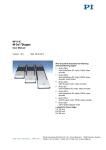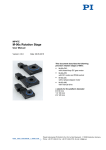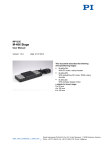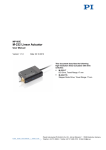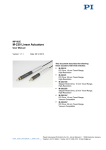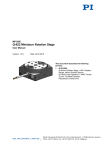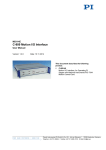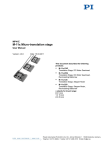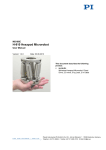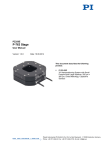Download User Manual MP126E - Physik Instrumente
Transcript
MP126E M-417 Stage User Manual Version: 1.0.0 Date: 25.06.2014 This document describes the following stage: M-417.2PD Linear Translation Stage with Recirculating Ballscrew, Travel Range 500 mm, ActiveDrive DC Motor (Includes 24 V Power Supply) Physik Instrumente (PI) GmbH & Co. KG, Auf der Roemerstr. 1, 76228 Karlsruhe, Germany Phone: +49 721 4846-0, Fax: +49 721 4846-1019, E-mail: [email protected] Physik Instrumente (PI) GmbH & Co. KG is the owner of the following trademarks: PI®, PIC®, PICMA®, PILine®, PIFOC®, PiezoWalk®, NEXACT®, NEXLINE®, NanoCube®, NanoAutomation®, Picoactuator®, PInano® © 2014 Physik Instrumente (PI) GmbH & Co. KG, Karlsruhe, Germany. The text, photographs and drawings in this manual are protected by copyright. With regard thereto, Physik Instrumente (PI) GmbH & Co. KG retains all the rights. Use of said text, photographs and drawings is permitted only in part and only upon citation of the source. Original instructions First printing: 25.06.2014 Document number: MP126E, MMa, version 1.0.0 Subject to change without notice. This manual is superseded by any new release. The latest release is available for download (p. 3) on our website. Contents 1 About this Document 1.1 1.2 1.3 1.4 1.5 1.6 2 3 Goal and Target Audience of this User Manual ...................................................1 Symbols and Typographic Conventions ...............................................................1 Definition ...............................................................................................................2 Figures ..................................................................................................................3 Other Applicable Documents ................................................................................3 Downloading Manuals ..........................................................................................3 Safety 2.1 2.2 2.3 5 Intended Use ........................................................................................................5 General Safety Instructions ..................................................................................5 Organizational Measures......................................................................................6 Product Description 3.1 3.2 3.3 3.4 3.5 3.6 1 7 Product View.........................................................................................................7 Product Labeling ...................................................................................................8 Scope of Delivery .................................................................................................9 Accessories ..........................................................................................................9 Suitable Controllers ............................................................................................10 Technical Features .............................................................................................10 3.6.1 Limit Switches ...................................................................................10 3.6.2 Rotary Encoder .................................................................................11 3.6.3 Reference Point Switch ....................................................................12 3.6.4 Integrated PWM Amplifier.................................................................12 4 Unpacking 13 5 Installation 15 5.1 5.2 5.3 5.4 5.5 5.6 General Notes on Installation .............................................................................15 Mounting the M417 on a Surface ......................................................................16 Affixing the Load to the M417............................................................................20 5.3.1 Affixing the Load Directly on the Sled ..............................................21 5.3.2 Affixing the Load with the Mounting Adapter ....................................22 Setting Up a Multi-Axis System ..........................................................................25 5.4.1 General Information on Setting Up a Multi-Axis System ..................25 5.4.2 Setting Up an XY System .................................................................25 5.4.3 Setting Up a Z System ......................................................................28 Connecting the Motor Cable to the M417 .........................................................31 Connecting the Power Supply to the M417 .......................................................31 6 Start-Up 6.1 6.2 7 General Notes on Start-Up .................................................................................33 Starting up the Stage ..........................................................................................35 6.2.1 M417 Entries in the Stage Database of PI ......................................36 6.2.2 Operating Parameters ......................................................................36 Maintenance 7.1 7.2 7.3 8 33 General Notes on Maintenance ..........................................................................37 Performing a Maintenance Run ..........................................................................37 Cleaning the M417 ............................................................................................38 Troubleshooting 8.1 8.2 37 39 Possible Causes and Correction ........................................................................39 Manually Moving the Sled ..................................................................................41 9 Customer Service 43 10 Technical Data 45 10.1 10.2 10.3 Specifications......................................................................................................45 10.1.1 Data Table ........................................................................................45 10.1.2 Maximum Ratings .............................................................................46 10.1.3 Ambient Conditions and Classifications ...........................................46 10.1.4 Limit Switch Specifications ...............................................................47 10.1.5 Reference Point Switch Specifications .............................................47 Dimensions .........................................................................................................48 10.2.1 M417 Stage .....................................................................................48 10.2.2 M-417.AP1 Mounting Adapter ..........................................................49 Pin Assignment ...................................................................................................50 10.3.1 Sub-D 15 (m) Controller Connection ................................................50 10.3.2 M8 Power Supply Connector (m) .....................................................51 11 Old Equipment Disposal 53 12 EC Declaration of Conformity 55 1 About this Document 1 About this Document In this Chapter Goal and Target Audience of this User Manual ............................................................ 1 Symbols and Typographic Conventions ........................................................................ 1 Definition ........................................................................................................................ 2 Figures ........................................................................................................................... 3 Other Applicable Documents ......................................................................................... 3 Downloading Manuals ................................................................................................... 3 1.1 Goal and Target Audience of this User Manual This manual contains information on the intended use of the M417. It assumes that the reader has a fundamental understanding of basic servo systems as well as motion control concepts and applicable safety procedures. The latest versions of the user manuals are available for download (p. 3) on our website. 1.2 Symbols and Typographic Conventions The following symbols and typographic conventions are used in this user manual: WARNING Possibly hazardous situation If not avoided, the hazardous situation will result in serious injury. Actions to take to avoid the situation. CAUTION Dangerous situation If not avoided, the dangerous situation will result in minor injury. Actions to take to avoid the situation. NOTICE Dangerous situation If not avoided, the dangerous situation will result in damage to the equipment. M-417 Stage Actions to take to avoid the situation. MP126E Version: 1.0.0 1 1 About this Document INFORMATION Information for easier handling, tricks, tips, etc. Symbol/Label Meaning 1. Action consisting of several steps whose sequential order must be observed 2. Action consisting of one or several steps whose sequential order is irrelevant List item p. 5 Cross-reference to page 5 RS-232 Labeling of an operating element on the product (example: socket of the RS-232 interface) Warning sign on the product which refers to detailed information in this manual. 1.3 Definition Term Explanation Load capacity Maximum load capacity in the vertical direction when the stage is mounted horizontally. The contact point of the load is in the center of the moving part of the stage (e. g. platform, sled). Max. push/pull force Maximum force in the direction of motion. Some stages may have higher forces but with limited lifetimes. In the case of vertical mounting, the specified value (p. 45) only applies when the servo mode is on. Incremental position Sensor (encoder) for capturing changes of position or changes of angle. Signals from the incremental position sensor are sensor used for axis position feedback. After switching on the controller a reference point definition must be performed before absolute target positions can be commanded and reached. 2 Version: 1.0.0 MP126E M-417 Stage 1 About this Document 1.4 Figures For better understandability, the colors, proportions and degree of detail in illustrations can deviate from the actual circumstances. Photographic illustrations may also differ and must not be seen as guaranteed properties. 1.5 Other Applicable Documents The devices and software tools which are mentioned in this documentation are described in their own manuals. Controller Document C-863.11 DC Motor Controller MS205E User Manual C-843 DC Motor Controller PCI Board MS77E User Manual C-884 DC Motor Controller MS213E User Manual 1.6 Downloading Manuals INFORMATION If a manual is missing on our website or if there are problems in downloading: Contact our customer service department (p. 43). The current versions of the manuals are found on our website. For some products (e.g. Hexapod systems and electronics that are delivered with a CD), access to the manuals is password-protected. The password is stored on the CD. Download freely accessible manuals 1. Open the website http://www.pi-portal.ws. 2. Click Downloads. 3. Click the corresponding category (e.g. M Hexapods / Micropositioning) 4. Click the corresponding product code (e.g. M-417). 5. Click Documents. The available manuals are displayed. 6. Click the desired manual and save it on the hard disk of your PC or on a data storage medium. M-417 Stage MP126E Version: 1.0.0 3 1 About this Document Download password-protected manuals 1. Carry out steps 1 to 5 of the download process for freely accessible manuals. 2. Insert the product CD in the PC drive. 3. Switch to the Manuals directory on the CD. 4. In the Manuals directory, open the Release News (file including releasenews in the file name). 5. Find the user name and password in the User login for software download section in the Release News. 6. In the User login area on the left margin in the website, enter the user name and the password in the corresponding fields. 7. Click Login. The available manuals are displayed. 8. Click the desired manual and save it on the hard disk of your PC or on a data storage medium. 4 Version: 1.0.0 MP126E M-417 Stage 2 Safety 2 Safety In this Chapter Intended Use ................................................................................................................. 5 General Safety Instructions ........................................................................................... 5 Organizational Measures............................................................................................... 6 2.1 Intended Use The M417 is a laboratory device as defined by DIN EN 61010. It is intended to be used in interior spaces and in an environment which is free of dirt, oil and lubricants. In accordance with its design and realization, the M417 is intended for single-axis positioning, adjusting and shifting of loads at different velocities. The M417 is not intended for applications in areas in which a failure would present severe risks to human beings or the environment. The M417 is intended for horizontal or vertical mounting. For the load limits with vertical mounting, see "General Notes on Installation" (p. 15). The intended use of the M417 is only possible when completely mounted and connected. The M417 must be operated with a suitable controller (p. 10). The controller is not included in the scope of delivery of the M417. 2.2 General Safety Instructions The M417 is built according to state-of-the-art technology and recognized safety standards. Improper use can result in personal injury and/or damage to the M417. Only use the M417 for its intended purpose, and only use it if it is in a good working order. Read the user manual. Immediately eliminate any faults and malfunctions that are likely to affect safety. The operator is responsible for the correct installation and operation of the M417. M-417 Stage MP126E Version: 1.0.0 5 2 Safety If the stage is operated without the protective cover, the entanglement of body parts or objects (e. g. hair, jewelry or clothing) by the rotating drive screw can lead to serious injury. Only start up the M-417 when the protective cover is properly affixed (p. 16). There is a risk of minor injury from crushing between the moving parts of the stage or the load and a fixed part or obstacle. Use protective structures to keep limbs away from areas in which they could be seized by moving parts. Observe the safety distances in accordance with DIN EN ISO 13857 when installing protective structures. 2.3 Organizational Measures User manual Always keep this user manual available by the M417. The latest versions of the user manuals are available for download (p. 3) on our website. Add all information given by the manufacturer to the user manual, for example supplements or Technical Notes. If you pass the M417 on to other users, also turn over this user manual as well as other relevant information provided by the manufacturer. Only use the device on the basis of the complete user manual. Missing information due to an incomplete user manual can result in serious injury and property damage. Only install and operate the M417 after having read and understood this user manual. Personnel qualification The M417 may only be installed, started up, operated, maintained and cleaned by authorized and appropriately qualified personnel. 6 Version: 1.0.0 MP126E M-417 Stage 3 Product Description 3 Product Description In this Chapter Product View ................................................................................................................. 7 Product Labeling............................................................................................................ 8 Scope of Delivery .......................................................................................................... 9 Accessories ................................................................................................................... 9 Suitable Controllers ..................................................................................................... 10 Technical Features ...................................................................................................... 10 3.1 Product View Figure 1: Components of the M-417.2PD stage M-417 Stage 1 Protective cover 2 Moving sled 3 Motor cover 4 Controller connection (Sub-D 15 panel plug) 5 Power supply connection (M8 panel plug) 6 Base body x (Arrow:) Positive direction of motion (X axis) MP126E Version: 1.0.0 7 3 Product Description 3.2 Product Labeling Figure 2: Product labeling, position Position Labeling 1 Description Manufacturer's logo 1 WWW.PI.WS Manufacturer's address (website) 1 M-417.2PD Product name 1 SN: A13045786 Serial number (example), individual for each M417 Meaning of the places (counting from left): 1 = internal information, 2 and 3 = manufacturing year, 4 to 9 = consecutive numbers 1 Country of origin: Germany 1 Warning sign "Observe manual!" 1 Old equipment disposal (p. 53) 1 CE conformity mark 2 24 VDC Power supply connection 3 Controller Controller connection 4-7 8 Country of origin Version: 1.0.0 "Risk of crushing" warning sign MP126E M-417 Stage 3 Product Description 3.3 Scope of Delivery Item ID Component M417.2PD Stage according to order M-417.AP1 Mounting adapter for setting up a multi-axis system and for alternative affixing of the load 000049049 Screw set for attaching the stage, load and mounting adapters 4 M4x12-A2 hex-head cap screws ISO 4762 4 M5x12-A2 hex-head cap screws ISO 4762 4 M5x45-A2 hex-head cap screws ISO 4762 4 M5x50-A2 hex-head cap screws ISO 4762 6 M6x25-A2 hex-head cap screws ISO 4762 Allen wrench AF 3 DIN 911 Allen wrench AF 4 DIN 911 Allen wrench AF 5 DIN 911 C-815.38 Motor cable, 3 m, Sub-D 15 (m/f) MP119EK Short instructions for stages with electric motors 000023194 Wide-range-input power supply 24 V / 120 W 3763 Power cord K050B0003 Adapter for the power supply connection; barrel connector to M8 4-pin connector (f) 3.4 Accessories Order Number Description C-815.83 Motor cable, 10 m, Sub-D, 15-pin (m/f) To order, contact our customer service department (p. 43). M-417 Stage MP126E Version: 1.0.0 9 3 Product Description 3.5 Suitable Controllers The M417 must be connected to a suitable controller. The following controllers from PI are suitable for the operation of the M417: Controller Axes per controller PC interface Multiple controllers on the same PC C-843 2 or 4 Internal (PCI bus) Yes, separate boards C-863 1 USB, RS-232, daisy chain Yes, same interface C-884 1 to 4 USB, RS-232, TCP/IP Yes PC software is included in the scope of delivery of the controllers from PI. The operation of the controllers is described in the corresponding user manuals. 3.6 Technical Features 3.6.1 Limit Switches The M417 is equipped with noncontact, Hall-effect limit switches. The signals of the limit switches are used to stop the sled before the hard stop at both ends of the travel range. Figure 3: Limit switch arrangement with the M417 10 N1 Inner negative limit switch N2 Outer negative limit switch P1 Inner positive limit switch P2 Outer positive limit switch Version: 1.0.0 MP126E M-417 Stage 3 Product Description Limit switch function with the M417: Limit switch* Availability of the signal Function "Inner" limit switches N1 and P1 Output to the controller on When triggering takes place, the the Sub-D 15 panel plug controller switches off the servo mode for the affected axis and (p. 50) thereby stops the motion. See also "Limit Switch Specifications" (p. 47). "Outer" limit switches No connection to the N2 and P2 controller The sled can be moved away from the limit switch by command, see "Possible Causes and Correction" (p. 39). The triggering interrupts the power source of the drive via a relay. The sled cannot be moved away from the limit switch by command but must be moved manually (p. 41). The distance between N1 and N2 or P1 and P2 is approx. 5.3 mm in each case. INFORMATION In the case of controllers from PI, the permissible travel range of the stage is represented via parameters in the controller. Suitable parameter values can be loaded from a stage database in the supplied PC software; see also "M417 Entries in the Stage Database of PI" (p. 36). With the values loaded from the stage database for the lower and upper limit of the travel range, the limit switches cannot be approached with motion commands. The controller furthermore calculates the dynamic profile during the motion so that the stage decelerates in time before the end of the permissible travel range. The stage can only reach the limit switch in exceptional cases, e.g. with a very high velocity and/or under high load. For details, see the user manual of the controller. 3.6.2 Rotary Encoder The M417 is equipped with an optical rotary encoder. For the encoder resolution, refer to the table in the "Specifications" section (p. 45). A rotary encoder is implemented at a rotating point in the drivetrain, e.g. the motor shaft. M-417 Stage MP126E Version: 1.0.0 11 3 Product Description 3.6.3 Reference Point Switch The stage is equipped with a direction-sensing reference point switch that is located approximately in the middle of the travel range. This sensor transmits a TTL signal that indicates whether the stage is on the positive or negative side of the reference point switch. The commands that use the reference signal are described in the user manual of the controller and/or in the corresponding software manuals. 3.6.4 Integrated PWM Amplifier The M417 is equipped with a PWM amplifier ("ActiveDrive concept"). The motor and PWM amplifier are installed in a common case and thus optimally integrated and shielded. The PWM amplifier only receives the control signals from the controller, whereas the supply voltage is provided via an external power supply. The ActiveDrive concept allows a high motor power and dynamics with a low loss of power. 12 Version: 1.0.0 MP126E M-417 Stage 4 Unpacking 4 Unpacking 1. Unpack the M417 with care. 2. Compare the contents against the items covered by the contract and against the packing list. 3. Inspect the contents for signs of damage. If parts are missing or you notice signs of damage, contact PI immediately. 4. Keep all packaging materials in case the product needs to be returned. M-417 Stage MP126E Version: 1.0.0 13 5 Installation 5 Installation In this Chapter General Notes on Installation ...................................................................................... 15 Mounting the M417 on a Surface ............................................................................... 16 Affixing the Load to the M417 .................................................................................... 20 Setting Up a Multi-Axis System ................................................................................... 25 Connecting the Motor Cable to the M417 .................................................................. 31 Connecting the Power Supply to the M417 ................................................................ 31 5.1 General Notes on Installation NOTICE Unintentional changes in position with vertical mounting! If the load exceeds the self-locking of the drive when the stage is mounted vertically, unintentional changes in the position of the sled will occur. Unintentional changes in the position of the sled can damage the drive, the load or the environment. When a stage is mounted vertically, make sure that the installed load is less than 10 N. NOTICE Protruding screw heads! Protruding screw heads can damage the M417. Ensure that the screw heads do not protrude from counter-sunk holes so that they do not interfere with the stage motion. NOTICE Cable break! A cable break leads to a failure of the stage. M-417 Stage Install the stage so that the cable is not bent or squeezed too severely during operation. MP126E Version: 1.0.0 15 5 Installation NOTICE Heating up of the M-417 during operation! The heat produced during operation of the M417 can affect your application. Install the M417 so that your application is not affected by the dissipating heat. INFORMATION For optimum repeatability, all components must be affixed without backlash. Make sure that the stage, load and - if present - the mounting adapter are affixed without backlash. If possible, carry out a simulation of the stage motions with a mounted load or suitable calculations in order to identify collisions or unfavorable center of gravity constellations. If necessary, take suitable constructive measures to avoid collisions and instabilities in the overall system. Avoid or mark danger zones that result from the installation of the stage and the application, in accordance with the legal regulations. 5.2 Mounting the M-417 on a Surface NOTICE Warping of the M-417 due to mounting on uneven surfaces! Mounting the M417 on an uneven surface can warp the M417. Warping reduces the accuracy. Mount the M417 on an even surface. The recommended evenness of the surface is ≤10 µm. For applications with great temperature changes: Only mount the M417 on surfaces that have the same or similar thermal expansion properties as the M417. INFORMATION The positive direction of motion is away from the cable exit side. INFORMATION The following holes in the base body of the stage can be used to mount the M417 on a surface: 16 Ø 5.5 mm holes Ø 6.6 mm holes Version: 1.0.0 MP126E M-417 Stage 5 Installation Prerequisites You have read and understood the general notes on installation (p. 15). You have provided a suitable surface (for the required position and depth of the holes for accommodating the screws, see "Dimensions" (p. 48)): − When the Ø 5.5 mm holes are used: Four M5 holes with sufficient depth are present. − When the Ø 6.6 mm holes are used: Six M6 holes with sufficient depth are present. − The evenness of the surface is ≤ 10 µm. − For applications with great temperature changes: The surface should have the same thermal expansion properties as the M417 (e.g. surface made of aluminum). You have accounted for the space required for a cable routing free of kinks and in accordance with regulations. The stage is not connected to the power supply and the controller. Tools and accessories When the Ø 5.5 mm holes are used; mounting accessories in the scope of delivery (p. 9): 4 M5x50 screws Allen wrench AF 4 When the Ø 6.6 mm holes are used; mounting accessories in the scope of delivery (p. 9): M-417 Stage 6 M6x25 screws Allen wrench AF 5 Allen wrench AF 4 for manually moving the sled Allen wrench AF 3 for removing and affixing the protective cover MP126E Version: 1.0.0 17 5 Installation Mounting the stage on Ø 5.5 mm holes Figure 4: Position of the Ø 5.5 mm mounting holes in the base body of the stage 1. If necessary, make the Ø 5.5 mm mounting holes in the base body of the stage accessible by manually moving the sled (p. 41). 2. Align the stage on the surface so that the corresponding mounting holes in the stage and the surface overlap. 3. Screw the screws into all mounting holes. 4. Make sure that the screw heads do not protrude from the counter-sunk holes. 5. Check that the stage fits on the surface without backlash. Mounting the stage on Ø 6.6 mm holes 1. Remove the protective cover: Figure 5: Position of the screws for affixing the protective cover a) b) c) 18 Loosen the eight M4x8 mounting screws with which the protective cover is affixed to the M417 (see figure). Remove the loosened screws. Remove the protective cover. Version: 1.0.0 MP126E M-417 Stage 5 Installation 2. If necessary, make the Ø 6.6 mm mounting holes in the base body of the stage accessible by manually moving the sled (p. 41). Figure 6: Position of the Ø 6.6 mm mounting holes in the base body of the stage (protective cover removed, sled slightly indicated) 3. Align the stage on the surface so that the corresponding mounting holes in the stage and the surface overlap. 4. Screw the screws into all mounting holes. 5. Make sure that the screw heads do not protrude from the counter-sunk holes. 6. Check that the stage fits on the surface without backlash. 7. Affix the protective cover to the stage: a) b) c) M-417 Stage Place the protective cover on the base body of the stage so that the corresponding holes overlap. Screw in the eight M4x8 screws completely. Check that the protective cover fits without backlash. MP126E Version: 1.0.0 19 5 Installation 5.3 Affixing the Load to the M-417 NOTICE Impermissibly high load on the stage! An impermissibly high load interferes with the motion of the sled and can damage the stage. For the mounting type and mass of the load, observe the maximum permissible forces that are allowed to act on the sled according to the specification (p. 45). INFORMATION You can affix a load on the M417 in the following ways: Directly on the moving sled. Advantages: More compact structure, lower total weight, lower moving mass, shorter total set-up time On the M-417.AP1 mounting adapter, which is affixed to the moving sled. Advantages: More mounting options, easier optimization of the center of gravity in the case of inhomogeneous loads Figure 7: Holes in the moving sled (left) and in the M-417.AP1 mounting adapter (right, shown transparent) 1 M5 (for affixing the load or mounting a further stage as the Y axis (p. 25)) 2 Ø 4.8 mm (for affixing the load or mounting a further stage as the Z axis (p. 28)) 3 Ø 5.45 mm (for affixing the mounting adapter to the moving sled) 4 M6 (for affixing the load in the center) Other holes in the mounting adapter: M4 (for affixing the load), 28 pieces Exact position and depth of the holes: See "Dimensions" (p. 48). 20 Version: 1.0.0 MP126E M-417 Stage 5 Installation 5.3.1 Affixing the Load Directly on the Sled NOTICE Contact between the load and the protective cover of the stage! Contact between the load and the protective cover of the stage interferes with the motion of the sled and can damage the stage and/or load. Design the load so that no contact is possible between the load and the protective cover. NOTICE Warping of the sled! Unsuitable affixing of the load can warp the sled of the M417. Warping of the sled will increase wear and reduce accuracy. Only affix loads with an even surface to the sled. The recommended evenness of the load surface is 50 μm. For applications with great temperature changes: Only affix loads on the sled that have the same or similar thermal expansion properties as the M417 (e. g. loads made of aluminum). NOTICE Screws that are too long! Screws that are inserted too deeply can damage the M417. Observe the depth of the mounting holes in the sled of the stage. Only use screws of the correct length for the respective mounting holes. Prerequisites You have read and understood the general notes on installation (p. 15). You have properly attached the stage to a surface (p. 16). The stage is not connected to the power supply and the controller. You have prepared the load so that it can be affixed to the mounting holes in the sled of the stage: M-417 Stage − The center of gravity of the load is positioned as centrally as possible on the sled. − At least two points are provided for affixing the load to the sled (ideally: three or four attachment points). MP126E Version: 1.0.0 21 5 Installation Tools and accessories At least 2 M5 screws with suitable length (4 M5x12 screws in the scope of delivery (p. 9)) Suitable tools for fastening the screws (Allen wrench AF 4 in the scope of delivery (p. 9)) Affixing the load directly to the sled Figure 8: Position of the mounting holes for the load (M5 depth 10 mm) on the sled of the stage 1. Align the load so that the selected mounting holes in the sled can be used for affixing it. The arrangement of the mounting holes in the sled of the stage can be found in the above figure as well as in the dimensional drawing (p. 48). 2. Affix the load to the selected mounting holes in the sled using the screws. 3. Check that the load fits on the sled without backlash. 5.3.2 Affixing the Load with the Mounting Adapter NOTICE Screws that are too long! Screws that are inserted too deeply can damage the M417. 22 Observe the depth of the mounting holes in the sled of the stage. Only use screws of the correct length for the respective mounting holes. Avoid that screws protrude into the space between the bottom side of the mounting adapter and the protective cover of the M417. Version: 1.0.0 MP126E M-417 Stage 5 Installation INFORMATION The sequence of the following mounting steps depends on the dimensions of the load and the selection of the mounting holes in the mounting adapter: Affixing the mounting adapter to the sled of the M417 Select the sequence of the mounting steps according to the configuration of your set-up. Affixing the load to the mounting adapter Prerequisites You have read and understood the general notes on installation (p. 15). You have properly attached the stage to a surface (p. 16). The stage is not connected to the power supply and the controller. You have prepared the load so that it can be affixed to the mounting holes in the mounting adapter: − The distance between the center of gravity of the load and the center of the mounting adapter is as small as possible in all directions. − At least two points are provided for affixing the load to the mounting adapter (ideally: three or four attachment points). Tools and accessories M-417 Stage M-417.AP1 mounting adapter, in the scope of delivery (p. 9) Mounting accessories for affixing the mounting adapter to the sled, in the scope of delivery (p. 9) − 4 M5x12 screws − Allen wrench AF4 At least 2 screws of suitable length for affixing the load on the mounting adapter. Options: − M4 screws (for mounting from below or above) − M5 screws (for mounting from above) − M6 screw (for mounting from above) Suitable tools for fastening the screws MP126E Version: 1.0.0 23 5 Installation Affixing the mounting adapter to the sled Figure 9: Affixing the mounting adapter (shown transparent) to the sled 1. Position the M-417.AP1 mounting adapter on the sled of the M417 (see figure above): − The counterbores in the required holes of the mounting adapter are pointing upwards. − The required holes in the mounting adapter and sled overlap. 2. Completely screw one M5x12 screw into each of the holes. 3. Check that the mounting adapter fits on the sled of the stage without backlash. Affixing the load to the mounting adapter 1. Align the load so that the selected mounting holes in the mounting adapter can be used to affix it. 2. Affix the load to the selected mounting holes (p. 20) in the mounting adapter using the appropriate screws. 3. Make sure that the screw heads do not protrude from the counter-sunk holes. 4. Check that the load fits on the mounting adapter without backlash. 24 Version: 1.0.0 MP126E M-417 Stage 5 Installation 5.4 Setting Up a Multi-Axis System 5.4.1 General Information on Setting Up a Multi-Axis System NOTICE Impermissibly high forces and torques! Impermissibly high forces and torques that are applied to the stages in a multi-axis system can damage the stages. Include the masses of the moved stages and mounting adapters in the calculation of the load to be moved. For the mounting type and mass of the load, observe the maximum permissible forces according to the specifications for the individual stages. Avoid tilting torques on the sled of the M417 and the moving platforms of the other stages: For the individual stages, make sure that the load is positioned as centrally as possible on the sled or the moving platform. When the motion axis of the stage is oriented vertically, make sure that the installed load is lower than the holding force of the drive. Only install and operate the multi-axis system after you have read and understood the user manuals of all components of the multi-axis system. If you require special mounting adapters, contact our customer service department (p. 43). Possible combinations The following stages from PI can be combined with the M417: M-403 M-404 M-413 M-414 The listed stages can each be mounted on the M417 as either a Y or Z axis. 5.4.2 Setting Up an XY System NOTICE Screws that are too long! Mounting from below: Screws that are inserted too deeply can damage the M417. M-417 Stage Observe the depth of the mounting holes in the base body of the M417 (p. 48). Only use screws of the correct length for the respective mounting holes. MP126E Version: 1.0.0 25 5 Installation Designations in these instructions: Lower stage: M417, forms the basis of the multi-axis system (X axis), is attached to a surface Upper stage: Forms the Y-axis of the multi-axis system, is attached to the lower stage rotated by 90° Prerequisites You have read and understood the general notes on installation (p. 15). You have read and understood the general notes on setting up a multi-axis system (p. 25). You have accounted for the space required for a cable routing free of kinks and in accordance with regulations. The used stages are disconnected from the power supply and controller. You have properly attached the lower stage to a surface (p. 16). Tools and accessories M-417.AP1 mounting adapter, in the scope of delivery (p. 9) M-403, M-404, M-413 or M-414 stage as the Y axis ("upper stage") Allen wrench AF 4, in the scope of delivery (p. 9) 4 M5x12 screws for affixing the mounting adapter to the sled, in the scope of delivery (p. 9) 4 M5x45 screws for mounting the upper stage on the mounting adapter, in the scope of delivery (p. 9) Setting up an XY system Figure 10: XY system 26 1 Lower stage (M-417) 2 Upper stage (here: M-413.1xx or M-414.1xx) 3 Mounting adapter (M-417.AP1) Version: 1.0.0 MP126E M-417 Stage 5 Installation Figure 11: Setting up an XY system 1 Lower stage (M-417) 2 Upper stage (platform shown semi-transparent) 3 M-417.AP1 mounting adapter a-h: Mounting holes: Holes that overlap during attachment are marked with the same letter 1. Affix the mounting adapter to the sled of the lower stage (M-417) according to the instructions in "Affixing the Load with the Mounting Adapter" (p. 22). 2. If necessary: Make the required mounting holes in the base body of the upper stage accessible. Possible measures: M-417 Stage − Temporary start-up of the upper stage and commanding the platform to a suitable position − If possible: Manually move the platform of the upper stage (see manual of the upper stage) MP126E Version: 1.0.0 27 5 Installation 3. Position the upper stage on the mounting adapter so that the holes e to h overlap (see figure above). 4. Completely screw one M5x45 screw into each of the holes. 5. Check that the upper stage fits on the mounting adapter without backlash. 5.4.3 Setting Up a Z System NOTICE Screws that are too long! Screws that are inserted too deeply can damage the M417. Observe the depth of the mounting holes in the sled of the stage. Only use screws of the correct length for the respective mounting holes. Designations in these instructions: 28 Lower stage: M-417, forms the basis of the multi-axis system (X axis), is attached to a surface. Upper stage: Forms the Z axis of the multi-axis system, is mounted in a vertical alignment to the lower stage. Transverse mounting and longitudinal mounting: Marking of the orientation of the upper stage, see following table. Version: 1.0.0 MP126E M-417 Stage 5 Installation Transverse mounting Longitudinal mounting Figure 12: Z system with transverse mounting Figure 13: Z system with longitudinal mounting 1 Lower stage (M-417) 2 Upper stage (here: M-413.1xx or M-414.1xx) 3 Mounting adapter (M-417.AP1) Prerequisites You have read and understood the general notes on installation (p. 15). You have read and understood the general notes on setting up a multi-axis system (p. 25). You have accounted for the space required for a cable routing free of kinks and in accordance with regulations. The used stages are disconnected from the power supply and controller. You have properly attached the lower stage to a surface (p. 16). Tools and accessories M-417 Stage M-417.AP1 mounting adapter, in the scope of delivery (p. 9) Allen wrench AF 3, in the scope of delivery (p. 9) Allen wrench AF 4, in the scope of delivery (p. 9) M-403, M-404, M-413 or M-414 stage as the Z axis ("upper stage") 2 M4x12 screws for affixing the upper stage to the mounting adapter, in the scope of delivery (p. 9) 4 M5x12 screws for affixing the mounting adapter to the lower stage, in the scope of delivery (p. 9) MP126E Version: 1.0.0 29 5 Installation Setting up a Z system Figure 14: Holes for mounting the Z axis 1 Lower stage (M-417) 2 Upper stage 3 Mounting adapter (M-417.AP1; 3A: Bottom side, 3B: Top side) a-g: Mounting holes: a, c: For longitudinal mounting b, d: For transverse mounting Holes that overlap during mounting are marked with the same letter 1. Affix the mounting adapter to the upper stage. 30 a) Align the mounting adapter on the front side of the upper stage: − The top side of the mounting adapter points to the upper stage. − For transverse mounting: Holes b and d overlap. − For longitudinal mounting: Holes a and c overlap. b) Screw one M4x12 screw into each of the selected holes. Version: 1.0.0 MP126E M-417 Stage 5 Installation c) d) Make sure that the screw heads do not protrude from the counter-sunk holes. Check that the mounting adapter fits on the upper stage without backlash. 2. Affix the mounting adapter to the lower stage (M417): a) b) c) Position the mounting adapter to which the upper stage is affixed on the sled of the lower stage: The required mounting holes in the mounting adapter and sled of the lower stage overlap (holes e to h). Completely screw one M5x12 screw into each of the holes. Check that the mounting adapter fits on the lower stage without backlash. 5.5 Connecting the Motor Cable to the M-417 Prerequisites You have read and understood the general notes on installation (p. 15). The motor cable is not connected to the controller. Tools and accessories Suitable motor cable from PI, e.g.: − Motor cable C-815.38, 3 m, Sub-D, 15-pin (m/f), in the scope of delivery (p. 9). − Motor cable C-815.83, 10 m, Sub-D, 15-pin (m/f), available as optional accessory (p. 9). Connecting the motor cable to the M-417 1. Connect the connector (f) of the motor cable to the Sub-D 15-pin panel plug (m) of the stage. 2. Secure the connector (f) with the two integrated screws against being unintentionally pulled out of the stage. 5.6 Connecting the Power Supply to the M-417 Prerequisites The power cord is not connected to the power socket. Tools and accessories M-417 Stage Included 24 V wide-range-input power supply (for line voltages between 100 and 240 VAC at 50 or 60 Hz) Alternatively: Sufficiently dimensioned power supply that provides 24 VDC with a maximum of 5.0 ampere Included adapter for the power supply connection; barrel connector to M8 4pin connector (f) Alternatively: Sufficiently dimensioned adapter MP126E Version: 1.0.0 31 5 Installation Included power cord Alternatively: Sufficiently dimensioned power cord Connecting the power supply to the M-417 Connect the M8 connector (f) of the adapter with the M8 panel plug of the M417. Connect the barrel connector of the adapter to the barrel connector socket of the power supply. Connect the power cord to the power supply. 32 Version: 1.0.0 MP126E M-417 Stage 6 Start-Up 6 Start-Up In this Chapter General Notes on Start-Up .......................................................................................... 33 Starting up the Stage ................................................................................................... 35 6.1 General Notes on Start-Up WARNING Entanglement hazard by rotating drive screw! If the stage is operated without the protective cover, the entanglement of body parts or objects (e. g. hair, jewelry or clothing) by the rotating drive screw can lead to serious injury. Only start up the M-417 when the protective cover is properly affixed (p. 16). CAUTION Risk of crushing by moving parts! There is a risk of minor injury from crushing between the movable parts of the stage or the load and a fixed part or obstacle. Use protective structures to keep limbs away from areas in which they could be seized by moving parts. Observe the safety distances in accordance with DIN EN ISO 13857 when installing protective structures. NOTICE Damage from collisions! Collisions can damage the stage, the load to be moved and the environment. M-417 Stage Make sure that no collisions are possible between the stage, the load to be moved and the environment in the motion range of the stage. Do not place any objects in areas where they can get caught by moving parts. Stop the motion immediately if a controller malfunction occurs. If possible, adapt the travel range limits of your mechanical system in the software that you use for commanding the motion. MP126E Version: 1.0.0 33 6 Start-Up NOTICE Damage if an incorrect controller is connected! Connecting a stage to an unsuitable controller can cause damage to the stage or controller. Connect a stage with DC motor to a DC motor controller only. If you use controllers and software from other manufacturers, check their technical data to make sure that they are suitable before starting up the stage! NOTICE Operating voltage too high or incorrectly connected! Operating voltages that are too high or incorrectly connected can cause damage to the M417. Do not exceed the operating voltage range (p. 46) for which the M417 is specified. Only operate the M417 when the operating voltage is properly connected; see "Pin Assignment" (p. 50). NOTICE Damage or considerable wear from high accelerations! High accelerations can cause damage to or considerable wear on the mechanical system. Stop the motion immediately if a controller malfunction occurs. Ensure that the end of the travel range is approached at low velocity. Determine the maximum velocity for your application. NOTICE Unintentional motions! When the M417 is being connected to the controller, it can carry out unintentional motions. Defective software or wrong operation of the software can also result in unintentional motions. 34 Do not place any objects in areas where they can get caught by moving parts. Before connecting the M417, check whether a macro is defined as the start-up macro in the controller, and cancel the selection of the start-up macro if necessary. Version: 1.0.0 MP126E M-417 Stage 6 Start-Up INFORMATION The repeatability of the positioning is only ensured when the reference point switch is always approached from the same side. Controllers from PI fulfill this requirement as a result of the automatic direction sensing for reference moves to the reference switch. INFORMATION Unsuitable settings made to the servo-control parameters can impair the performance of the M417. This can have the following consequences: Oscillations If the performance of the M417 is not satisfactory, check the settings for the servo-control parameters of your controller. Imprecise approach of the position Settling time is too long 6.2 Starting up the Stage Prerequisites You have read and understood the General Notes on Start-Up (p. 33). For starting up with a load or in a multi-axis system: You have properly installed the stage (p. 25). You have read and understood the user manual of the used controller. You have read and understood the manual of the used PC software. The controller and the required PC software have been installed. All connections on the controller have been set up (see user manual of the controller; the stage is connected via the motor cable). Starting up the stage 1. Connect the power cord of the power supply with the power socket. 2. Start up the controller (see user manual of the controller). Configure the controller during the start-up using the PC software for the used stage (see user manual of the controller and of the PC software) − If you use a controller from PI: Select the entry in the stage database that precisely fits the used stage model (p. 36). − If you use a controller from another manufacturer: Enter the parameters (p. 36) that precisely fit the used stage model in the corresponding PC software. 3. Start a few motion cycles for testing purposes (see user manual of the controller). M-417 Stage MP126E Version: 1.0.0 35 6 Start-Up 6.2.1 M-417 Entries in the Stage Database of PI For controllers from PI, you can select the connected stage from a stage database in the corresponding PC software. The appropriate operating parameters are thus loaded to the controller. You can find a detailed description in the user manual for the controller or in the manual for the PC software used. 6.2.2 Operating Parameters If you use a DC motor controller from a third-party supplier, it may be necessary to enter operating parameters for adaptation to the used stage. 36 Parameter M-417 Unit P-Term 180 - I-Term 45 - D-Term 300 - I-Limit 2000 - Maximum acceleration 200000 counts/s² Maximum velocity 100 mm/s Maximum velocity 200000 counts/s Gear ratio - - Encoder resolution 2000 counts/mm Limit switch polarity Active high - Version: 1.0.0 MP126E M-417 Stage 7 Maintenance 7 Maintenance In this Chapter General Notes on Maintenance ................................................................................... 37 Performing a Maintenance Run ................................................................................... 37 Cleaning the M417 ..................................................................................................... 38 7.1 General Notes on Maintenance NOTICE Damage due to improper maintenance! Improper maintenance can lead to misalignment and failure of the M417. Only loosen screws according to the instructions in this manual. 7.2 Performing a Maintenance Run Depending on the operating conditions and the period of use of the M417, the following maintenance measures are required: Maintenance run The maintenance run serves to distribute the lubricant that is present. After 500 operating hours or at least after 1 year, carry out a maintenance run over the entire travel range, in order for the lubricant present to be equally distributed. If you operate your stage continuously over only a small working range (<20% of the entire travel range), perform a run across the entire travel range approximately every 2000 motion cycles. M-417 Stage MP126E Version: 1.0.0 37 7 Maintenance Lubrication Under laboratory conditions, the stage needs extra lubrication in exceptional cases only. For continuous industrial use, the lubrication intervals must be defined individually. Do not lubricate the M417 without consulting our customer service department (p. 43). To lubricate, follow the instructions given in the maintenance manual which you can obtain from our customer service department. 7.3 Cleaning the M-417 Prerequisites You have disconnected the stage from the controller. Cleaning the stage When necessary, clean the stage surface with a cloth lightly dampened with a mild cleanser or disinfectant. Do not use any organic solvents. 38 Version: 1.0.0 MP126E M-417 Stage 8 Troubleshooting 8 Troubleshooting In this Chapter Possible Causes and Correction ................................................................................. 39 Manually Moving the Sled ........................................................................................... 41 8.1 Possible Causes and Correction Problem Possible Causes Solution Reduced positioning accuracy Warped base body Mount the M417 on an even surface. The recommended evenness of the surface is 10 μm. When the stage is mounted vertically: The load exceeds the self-locking of the drive. Reduce the load. Make sure that the load does not exceed 10 N. Increased wear due to small motions over a long period of time Functional impairment after system modification Controller has been replaced. Carry out a maintenance run over the entire travel range (p. 37). Controller from PI: M417 has been replaced with another model. Load the parameters from the stage database that correspond to the combination of controller and M417 model. Controller from a third-party supplier: M-417 Stage MP126E Check the operating parameters. Version: 1.0.0 39 8 Troubleshooting Problem Possible Causes Solution Mechanical system does not move; no operating noise can be heard. Controller and/or power supply are incorrectly connected or defective. Check all connection cables. Check the controller. Check the power supply of the stage. When a PI controller is used: Motion error = The difference between the A motion error of the axis is current position and the commanded position exceeds the prescribed maximum value in present. closed-loop operation. Motion errors can be caused, for example, by malfunctions of the drive or the position sensor of the stage. 1. Read out the error code of the controller in the PC software. If a motion error is present, the error code -1024 is output. 2. Check your system and make sure that all axes can be moved safely. 3. Switch on the servo mode for the affected axis in the PC software. For details, see the user manual of the controller. Sled has triggered the "inner" If you use a controller from PI: limit switch (p. 10). 1. Switch on the servo mode for the affected axis again in the PC software. 2. Command an axis motion away from the limit switch in the PC software. Sled has triggered the "outer" limit switch (p. 10). Manually move the sled away from the limit switch. (p. 41) If the problem that occurred with your system is not listed in the table above or cannot be solved as described, contact our customer service department (p. 43). 40 Version: 1.0.0 MP126E M-417 Stage 8 Troubleshooting 8.2 Manually Moving the Sled INFORMATION In the following cases, it can be necessary to manually move the sled: Make mounting holes in the base body of the stage accessible. Move the sled away from the outer limit switch in order to make the stage operational again. Figure 15: Position of the drive screw access Prerequisites The stage is not connected to the power supply and the controller. Tools M-417 Stage Allen wrench AF 4, in the scope of delivery (p. 9) MP126E Version: 1.0.0 41 8 Troubleshooting Manually moving the sled 1. Introduce the Allen wrench into the drive screw access until you feel resistance. 2. Rotate the Allen wrench as far as necessary: − Clockwise rotation: Sled moves towards the drive screw access − Counter-clockwise rotation: Sled moves away from the drive screw access The rotary motion is transferred directly to the drive screw. 42 Version: 1.0.0 MP126E M-417 Stage 9 Customer Service 9 Customer Service For inquiries and orders, contact your PI sales engineer or send us an e-mail (mailto:[email protected]). If you have questions concerning your system, have the following information ready: Product codes and serial numbers of all products in the system Firmware version of the controller (if present) Version of the driver or the software (if present) Operating system on the PC (if present) The latest versions of the user manuals are available for download (p. 3) on our website. M-417 Stage MP126E Version: 1.0.0 43 10 Technical Data 10 Technical Data In this Chapter Specifications .............................................................................................................. 45 Dimensions .................................................................................................................. 48 Pin Assignment............................................................................................................ 50 10.1 Specifications 10.1.1 Data Table M-417.2PD Unit Travel range 500 mm Integrated sensor Rotary encoder Sensor resolution 4000 cts./rev. Design resolution 0.5 µm Min. incremental motion 0.5 µm Unidirectional repeatability 0.5 µm Backlash 2 µm Crosstalk, angular error ±100 µrad Max. velocity 100 mm/s Thread pitch 2 mm Gear ratio – Max. load 500 N Max. push / pull force 200 N Max. lateral force 200 N Motion and positioning Mechanical properties M-417 Stage MP126E Version: 1.0.0 45 10 Technical Data Drive properties Motor type DC motor with PWM control Operating voltage 24 (PWM) V Motor power 70 W Reference point and limit switches Hall effect Miscellaneous Operating temperature range -20 to 65 °C Material Aluminum, steel Mass 10.5 Connector Sub-D 15-pin, 3 m cable incl. Recommended controller / driver C-863 (single-axis), C-884 (up to 4 axes) kg Ask about custom designs! 10.1.2 Maximum Ratings The M417 is designed for the following maximum ratings: Maximum Operating Voltage Operating Frequency Maximum Power Consumption 24 V 0 Hz 70 W 10.1.3 Ambient Conditions and Classifications The following ambient conditions and classifications must be observed for the M417: Area of application For indoor use only Maximum altitude 2000 m Relative humidity Max. 80 % for temperatures up to 31 °C Decreasing linearly to 50 % at 40 °C 46 Storage temperature -20 °C to 80 °C Transport temperature -20 °C to 80 °C Supply fluctuations Not more than ±10 % of the nominal voltage Degree of pollution 2 Degree of protection according to IEC 60529 IP40 Version: 1.0.0 MP126E M-417 Stage 10 Technical Data 10.1.4 Limit Switch Specifications Type Magnetic (Hall-effect) sensor Supply voltage +5 V/GND, supply via the motor connector Signal output TTL level Signal logic Active high. When the limit switch is passed, the signal level changes: − − Normal motor operation: low (0 V) Limit switch reached: high (+5 V) 10.1.5 Reference Point Switch Specifications M-417 Stage Type Magnetic (Hall-effect) sensor Supply voltage +5 V/GND Signal output TTL level Signal logic Direction sensing by means of different signal levels on the left and right side of the reference point switch: The signal level changes from 0 to +5 V when the reference point switch is passed. MP126E Version: 1.0.0 47 10 Technical Data 10.2 Dimensions 10.2.1 M-417 Stage Dimensions in mm. Note that the decimal places are separated by a comma in the drawings. Figure 16: M-417 dimensions, sled in reference position 48 Version: 1.0.0 MP126E M-417 Stage 10 Technical Data 10.2.2 M-417.AP1 Mounting Adapter Dimensions in mm. Note that the decimal places are separated by a comma in the drawings. Figure 17: Dimensions of the M-417.AP1 mounting adapter M-417 Stage MP126E Version: 1.0.0 49 10 Technical Data 10.3 Pin Assignment 10.3.1 Sub-D 15 (m) Controller Connection Figure 18: Sub-D 15 (m) controller connection, front view Pin Signal Direction 1 - (not connected) - - (not connected) - - (not connected) - GND GND MAGN (PWM magnitude) Input SIGN (PWM sign) Input +5V Input Limit_N (negative limit switch) Output Limit_P (positive limit switch) Output Reference Output ID chip (for future use) Bidirectional Encoder A (+) Output Encoder A (-) Output Encoder B (+) Output Encoder B (-) Output 9 2 10 3 11 4 12 5 13 6 14 7 15 8 50 Version: 1.0.0 MP126E M-417 Stage 10 Technical Data 10.3.2 M8 Power Supply Connection (m) Figure 19: Phoenix M8 panel plug, front view M-417 Stage Pin Signal Direction 1 GND GND 2 GND GND 3 24 VDC supply voltage Input 4 24 VDC supply voltage Input MP126E Version: 1.0.0 51 11 Old Equipment Disposal 11 Old Equipment Disposal In accordance with the applicable EU law, electrical and electronic equipment may not be disposed of with unsorted municipal wastes in the member states of the EU. When disposing of your old equipment, observe the international, national and local rules and regulations. To meet the manufacturer’s product responsibility with regard to this product, Physik Instrumente (PI) GmbH & Co. KG ensures environmentally correct disposal of old PI equipment that was first put into circulation after 13 August 2005, free of charge. If you have old PI equipment, you can send it postage-free to the following address: Physik Instrumente (PI) GmbH & Co. KG Auf der Römerstr. 1 D-76228 Karlsruhe, Germany M-417 Stage MP126E Version: 1.0.0 53 12 EC Declaration of Conformity 12 EC Declaration of Conformity For the M417, an EC Declaration of Conformity has been issued in accordance with the following European directives: 2006/42/EC, Machinery Directive 2004/108/EC, EMC Directive 2011/65/EU, RoHS Directive The applied standards certifying the conformity are listed below. Safety of Machinery: EN 12100:2010 Electrical Safety: EN 61010-1:2010 EMC: EN 61326-1:2013 RoHS: EN 50581:2012 M-417 Stage MP126E Version: 1.0.0 55



























































